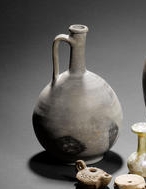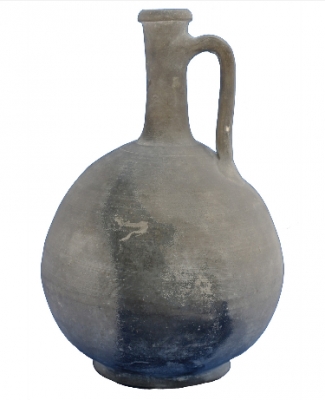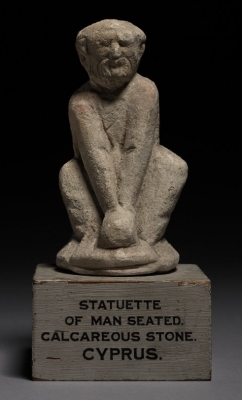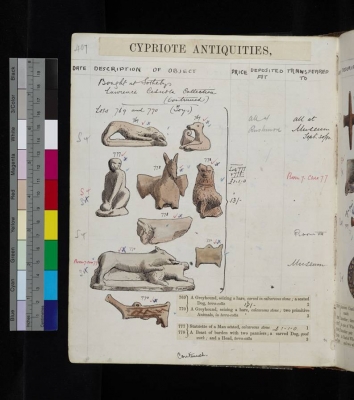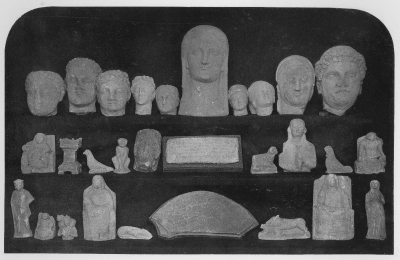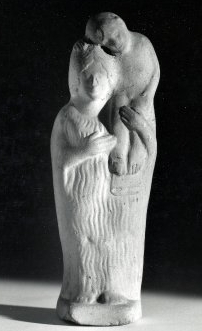As has been shown elsewhere on this site, the family eventually dispersed the second collection through sale-rooms, auctioneers and dealers. Most of the items from the Lawrence-Cesnola collection which were in this second collection are now dispersed throughout the world as part of the open art market. The location of most of them is unknown but below is the current location of those that are known or else information about auctions in which they were made available for sale.
Add.9455vol2_p33 /1
[Pictured twice on this webpage] This is a wine jug which Pitt-Rivers acquired on 15 May 1884 from Sotheby's. It seems to have had a confused history. It was apparently sold to a Welsh private collection and then sold to Trim Bridge Antiquities of Queen Street, Bath in December 1977 for £75. Subsequently it was sold at Bonhams, London on 6 October 2010 Antiquities sale 17855 as part of lot 321 It was on sale by Antiqutiesonline as at May 2012.
Add.9455vol2_p407 /3
This was a figurine of a greyhound seizing a hare, made from calcareous stone, which Pitt-Rivers bought between 12-14 March 1888 from Sotheby's.
It was bought by the British Museum from Charles Ede (a dealer) in 2012 in memory of their retired colleague Veronica Tatton-Brown. It had previously been owned by a private French collector. The British Museum described it as:
2012,5009.1 Cyprus 600 BC to 400 BC Cypro Classical I or Archaic II Limestone figurine of a dog eating a rabbit; carved; the figurine stands on an integral base, with an additional central support running the length of the piece; traces of red paint colour on the bodies of both animals. Excavated or collected by A. P. di Cesnola on Cyprus probably between 1876 and 1878 with funds supplied by Edwin Lawrence. Published in the photographic album of the Lawrence-Cesnola collection in 1881 and sold at the third sale of this collection at Sotheby's in June 1883 (Lot 770). It was purchased by Lt-General Ptt Rivers and transferred to the museum at his country home at Rushmore, Farnham, Dorset where it was entered in the manuscript catralogue (Cambridge University Library Add. 9455, Vol. 2, p. 407). The figurine was sold to a private French collector in the 20th century, and then to Charles Ede Ltd from from the BM acquired it in 2012.
Add.9455vol2_p407 /6
This page is illustrated with several images of one object, the figure of a potter, listed on page 407 of volume 2 of the second collection. It was purchased by Pitt-Rivers from Sotheby, Wilkinson and Hodge on either 12, 13 or 14 of March 1888, part of the Lawrence / Alessandro di Cesnola collection, described by Sotheby's as 'Lot 777 Statuette of a Man seated, calcareous stone'. Pitt-Rivers paid 13 shillings for it. It was first displayed in Rushmore, and than in Room 7 case 77 at Farnham Museum. It is not known when this object was first sold, or by whom but it was purchased from Charles Ede Limited by the British Museum in 2009 and now forms part of their Cypriot collections. [GR 2009,5007.1]
The British Museum in their on-line collections database describe the statue as:
Small limestone statuette of a bearded male, probably depicting a potter at work; he is in a semi-squatting position with his arms outstretched between his legs; he is kneading a rounded lump of material on a small cushion-shaped support, probably clay; both hands merge with the material he is handling; the body is represented in a somewhat schematic manner, but the head is more detailed indicative of the Cypro-Classical date; he has a triangular face with a flat crown, the unkempt hair indicated as a series of irregular incisions; he has a full beard and moustache; the stone is roughly carved with clear signs of chisel marks on the surface; traces of red paint on the upper body and lips. Height: 11.3 centimetres.
See Charles Ede catalogue (2008), no. 15. This is actually the figurine illustrated in A. di Cesnola, Salaminia (London, 1882), pl. X, no. 6 where it has been inaccurately drawn to represent a bound captive. However, a photograph of the same item is included in plate 59 of the catalogue of the Lawrence-Cesnola collection which is clearly the same as 2009,5007.1. For a comparable pose and subject from the Cypro-Archaic II period, see GR 1894,11-1.489 (Sculpture C225). The figures comes with the original wooden display base, on the underside of which is pencilled the text of the inscription.
A series of items from the Cesnola-Lawrence collections are known to have been sold by auction houses to unknown buyers. Here are the ones we have identified (there will be more)
Add.9455vol2_p422 /6
This figure holding a child was bought by Pitt-Rivers between 12-14 March 1888 from Sotheby's.
It was purchased by the British Museum from Charles Ede Ltd in 1992. It is described by the Museum as:
1992,0516.1 Terracotta figure of woman with child sitting on shoulder; mould-made front with a hand-made back which has been smoothed off with a knife; the woman stands in a frontal pose, feet together, with her left up raised to support the child, her right extending over her chest; she wears a pleated, sleeved chiton which falls to her feet; a scarf-like garment hangs over her left shoulder beneath the child; her long rippling hair is parted in the centre; the child is naturalistically rendered with his head leaning on his mother's; the figurine is made of pale cream clay, somewhat coarse texture, fired unevenly: the worn details suggest a old or heavily used mould. Height: 14.5 centimetres. c 500 BC Cypro-Archaic.
Bibliography: L. Burn, 'Three terracotta kourotrophoi', in: Periplous. Papers in classical art and archaeology presented to Sir John Boardman (2000), pp. 41-49.
Add.9455vol3_p838 /1
This Tympanum was bought by Pitt-Rivers on 27 April 1892 from Sotheby's. It was described in the catalogue of the 2nd collection as 'Ancient Christian Tympanum 24 x 41 inches elaborately carved designs in Byzantine style. The subjects are the Life and Passion of our Lord. Found in excavating for a house at Larnaca or Kittium. Fine white marble'. Pitt-Rivers spent a colossal £31.10.0 on the tympanum, far more than he usually spent at the Cesnola sales. It is now in the Victoria and Albert Museum [A.2-1982], see here for much more information about it.
Other Sales
Here are a series of objects sold at Christies in 1991 which cannot be matched to specific second collection catalogue entries because the details are too vague:
Christies, London sale on 29 April 1991 sale no. 4260,
Lot 199 was described as:
A Cypriot white painted bichrome pottery chalice, with twin handles, the body decorated with lines, chevrons and half circles, with swastikas in the field, repaired -- 6½in. (16.5cm.) diam., 8th-7th Century B.C.; and a quantity of other pottery vessels and wheels -- 8½in. (21.5cm.) high max., 1st millennium B.C., from Cyprus (a lot)See illustration for item one Lawrence Cesnola Collections. Lt. Gen. A. H. L. F. Pitt-Rivers Collection: many of the other items are inscribed as having been purchased from Sotheby's, 12 March 1888
Lot 200 was described as:
A large group of mainly Bronze Age Cypriot pottery including a black ware bowl, with white infilled incised linear decoration; two similar red ware double-handled globular jars, one damaged; another bowl, with incised lines and arcs; a burnished handled jug -- 6½in. (16.4cm.) high; and a Silesian pottery handled jar, of biconical form with decorated arcs divided by panels -- 4½in. (11.5cm.) high, all late 3rd-2nd millennium B.C. Lawrence Cesnola Collections Lt. Gen. A. H. L. F. Pitt-Rivers Collection
This lot sold for £880 to an unknown buyer.
General comments:
Many of the Cesnola-Lawrence items from the Pitt-Rivers second collection were later sold by Charles Ede limited (or his succeeding son). Thomas Kiely of the British Museum has drawn our attention to the Charles Ede Ltd catalogues. He remarks that 'two of the special Cypriot pottery catalogues specifically mentioned PR material, Cypriot Pottery IV (1976), nos 21, 25 to 28 and Cypriot Pottery V (1977), nos 34 and 36 to 38 (with the Queensland lamp-holder).' [pers comm. 24 May 2012] He also points out the following Pitt-Rivers pieces from the general Ede catalogues:
# 101, no. 15 (marble head)
# 104, no. 18 (horseman)
# 105, no. 10 (juglet) and no. 22 (glass bowl)
# 107, no. 27 (Mycenaean stirrup jar)
# 108, no. 28
# 116, no. 12
# 117, no. 19
# 122, nos 15 and 18.
At least one ex Pitt-Rivers piece is also listed in this source:
J. Webb 1997, Cypriote antiquities in Australian Collections. Corpus of Cypriot Antiquities 18. Studies in Mediterranean Archaeology XX: 18 (P. Äström: Jonsered), no. 104
Again, thanks to Thomas for pointing out this source. We are most grateful for his support, advice and research relating to the Pitt-Rivers' collection of Cesnola objects.
AP May 2012
